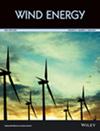风力发电机叶片负荷缓解的凸经济模型预测控制
IF 3.3
3区 工程技术
Q3 ENERGY & FUELS
引用次数: 1
摘要
经济模型预测控制(EMPC)由于其能够轻松地权衡经济目标而受到风能界越来越多的关注。然而,对于风力涡轮机应用来说,固有的非线性,例如来自空气动力学的非线性,给实现凸最优控制问题(OCP)带来了困难,通过该问题,不仅可以实现实时部署,而且可以保证全局最优解。变量变换可用于获得凸OCP,其中标称变量,如转速、俯仰角和扭矩,与功率和能量方面的替代集交换。随后的凸型EMPC (CEMPC)具有线性动力学、凸约束和凹经济目标,已成功地用于电力控制和塔架疲劳缓解。这项工作的重点是通过利用其单独的螺距控制(IPC)功能来扩展CEMPC框架的叶片负载缓解方面,从而产生一种新的CEMPC - IPC技术。这种扩展是通过重新制定静态叶片和转子力矩在个别叶片的空气动力和动力传动系统的旋转动能方面。在各种风况下的中保真度风力机仿真环境中展示了所提出方法的有效性,并与无负载缓解能力的基本CEMPC和基线IPC进行了比较。本文章由计算机程序翻译,如有差异,请以英文原文为准。
Convex economic model predictive control for blade loads mitigation on wind turbines
Abstract Economic model predictive control (EMPC) has received increasing attention in the wind energy community due to its ability to trade‐off economic objectives with ease. However, for wind turbine applications, inherent nonlinearities, such as from aerodynamics, pose difficulties in attaining a convex optimal control problem (OCP), by which real‐time deployment is not only possible but also a globally optimal solution is guaranteed. A variable transformation can be utilized to obtain a convex OCP, where nominal variables, such as rotational speed, pitch angle, and torque, are exchanged with an alternative set in terms of power and energy. The ensuing convex EMPC (CEMPC) possesses linear dynamics, convex constraints, and concave economic objectives and has been successfully employed to address power control and tower fatigue alleviation. This work focuses on extending the blade loads mitigation aspect of the CEMPC framework by exploiting its individual pitch control (IPC) capabilities, resulting in a novel CEMPC‐IPC technique. This extension is made possible by reformulating static blade and rotor moments in terms of individual blade aerodynamic powers and rotational kinetic energy of the drivetrain. The effectiveness of the proposed method is showcased in a mid‐fidelity wind turbine simulation environment in various wind cases, in which comparisons with a basic CEMPC without load mitigation capability and a baseline IPC are made.
求助全文
通过发布文献求助,成功后即可免费获取论文全文。
去求助
来源期刊

Wind Energy
工程技术-工程:机械
CiteScore
9.60
自引率
7.30%
发文量
0
审稿时长
6 months
期刊介绍:
Wind Energy offers a major forum for the reporting of advances in this rapidly developing technology with the goal of realising the world-wide potential to harness clean energy from land-based and offshore wind. The journal aims to reach all those with an interest in this field from academic research, industrial development through to applications, including individual wind turbines and components, wind farms and integration of wind power plants. Contributions across the spectrum of scientific and engineering disciplines concerned with the advancement of wind power capture, conversion, integration and utilisation technologies are essential features of the journal.
 求助内容:
求助内容: 应助结果提醒方式:
应助结果提醒方式:


